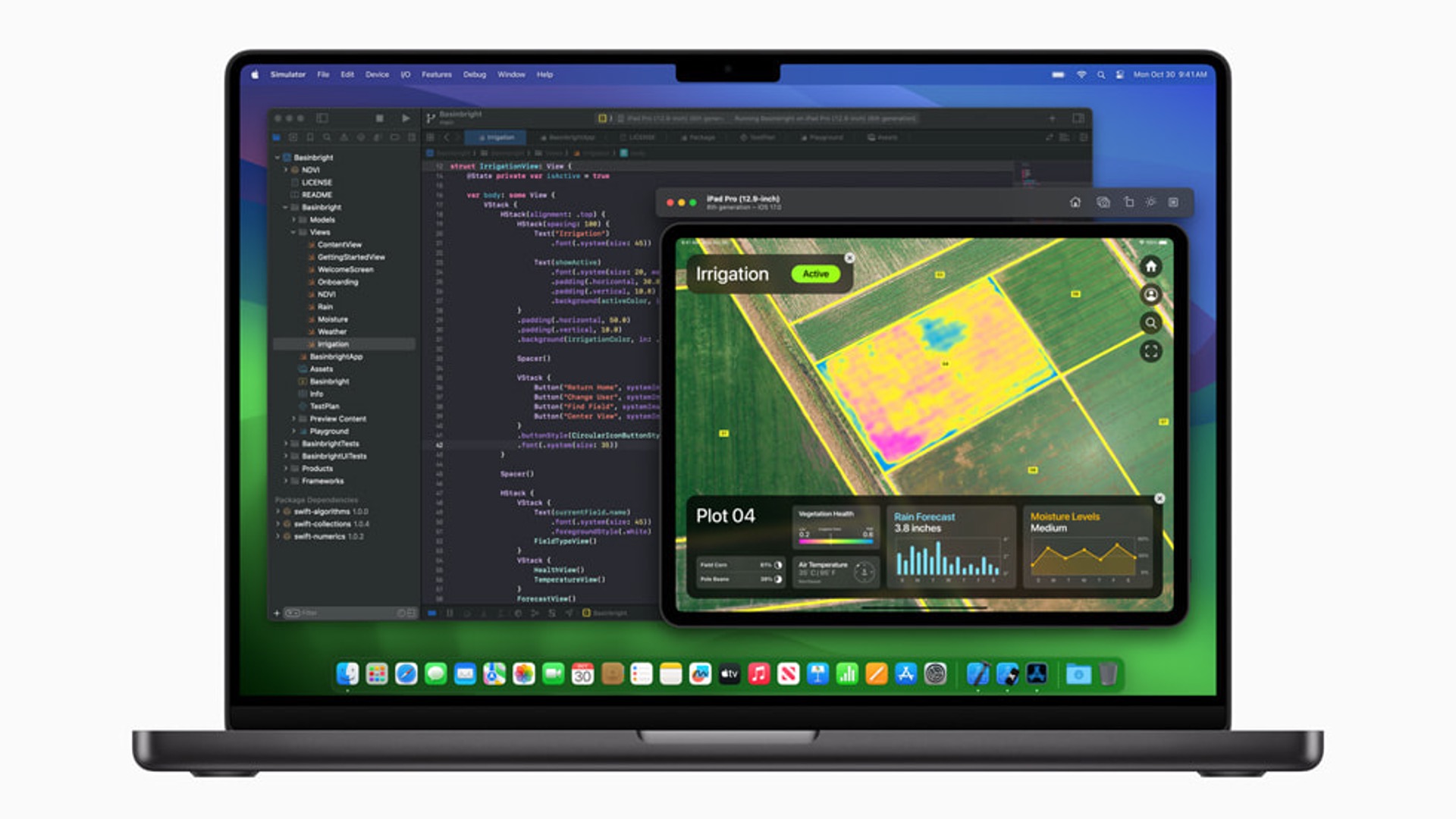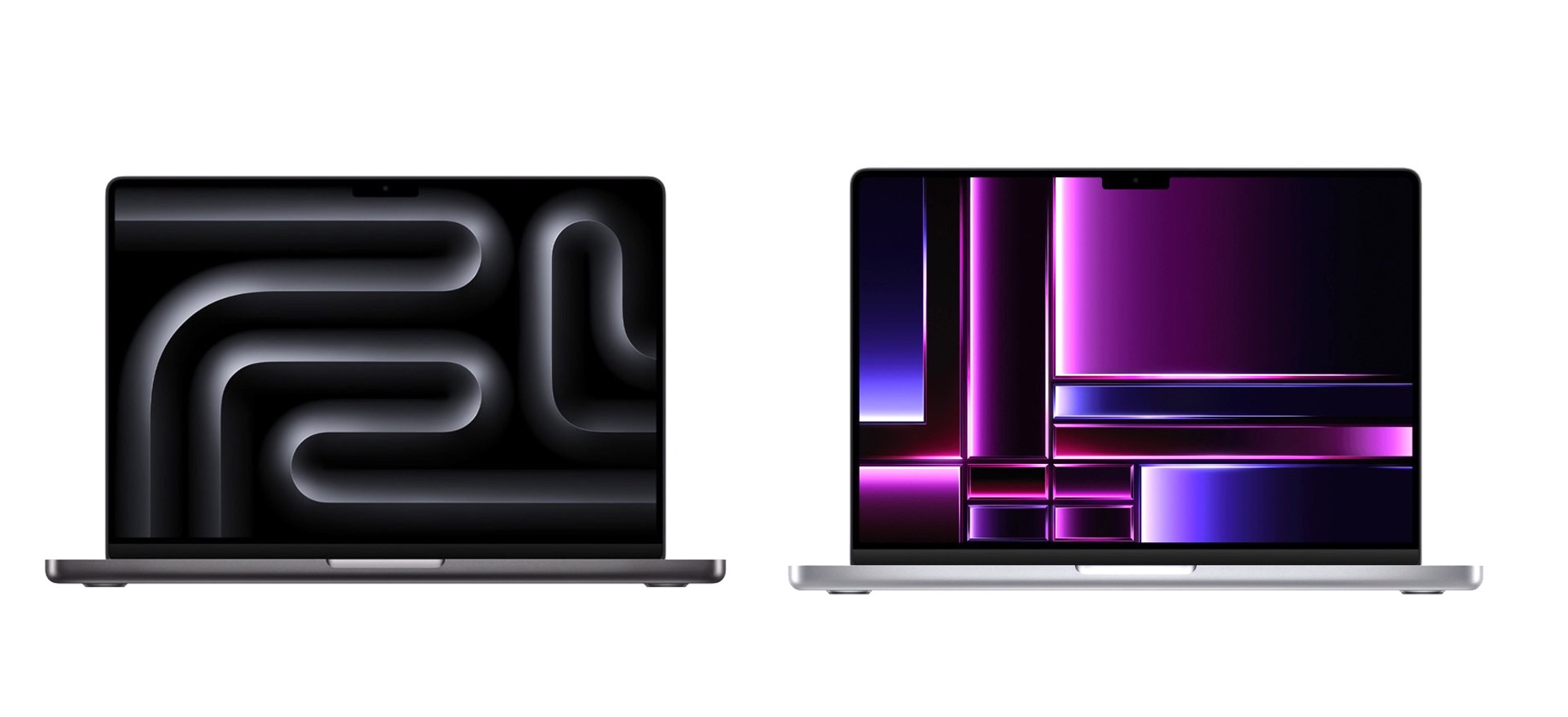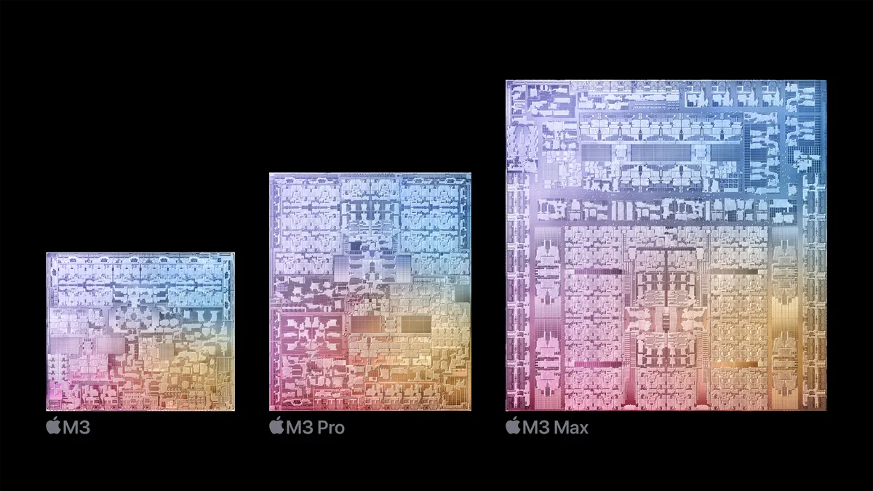The MacBook Pro M3 Max released on 1 November 2023 is Apple’s most powerful laptop developed to date, delivering more core CPUs and GPUs and more processing power than the M2 or M1 with new technological advancements. The M3 Pro Max are built using a new industry-leading 3-nanometer process which allows more transistors to be packed inside the chip to improve efficiency. The M3 Pro Max chip also features a next-generation GPU that delivers faster and more efficient performance and also features dynamic caching which allocates memory usage in real time and frees up memory for additional processes. This means that rendering speeds in graphics software such as DaVinci Resolve 18 Studio are now up to 2.5x faster according to Apple, and the CPU performance cores are 30-50% faster than those in the M1.
Furthermore, the M3 Pro Max also comes with accelerated ray tracing which allows apps to create extremely realistic and physically accurate images together with Apple’s new graphics architecture in the M3 models. The new GPU also provides accelerated mesh shading to the Mac and provides better capability to geometric processing. The M3 GPU is able to provide the same performance as the M1 chip using half the power, and up to 65% more performance at peak.

Processing Power
Perhaps the biggest improvement in the M3 Max models is the faster and more efficient CPU. These CPU performance cores are up to 30% faster than those in the M1 family and are roughly 14-20% faster than those in the M2 models. This makes the M3 Max particularly suited for compiling and testing millions of lines of code in Xcode and musicians can mix audio tracks in Logic Pro at even faster speeds. The CPU efficiency cores are also up to 50% faster than the efficiency cores in the M1 which improves performances and lengthens battery life.
One thing that we liked about the MacBook M3 Max is that both 14” and 16” MacBook Pro models come with 36GB of unified memory and 1TB SSD storage which makes these computers extremely fast and efficient. The highest RAM that the M3 Max has is up to 128GB of memory which is extremely massive – and can unlock workflows and processes that were previously only available on a desktop PC.
Another improvement that the MacBook Pro M3 Max has is the enhanced Neural Engine which is up to 60% faster than the M1, making AI/ML workflows much faster with powerful AI image processing tools and noise reduction in applications such as Topaz. Apple also says that those who use Adobe Premiere and Final Cut Pro should expect to see a performance increase.
Built-in transistors
One of the most unique aspects of the M3 Max is that it pushes the built-in transistor count up to 92 billion and out-performs any laptop currently available in the market in terms of GPU performance. The M3 Max has way more transistors than the M3 Pro which has 37 billion transistors and the standard M3 chip which only has 25 billion transistors. This means that in theory, the M3 Pro Max can performance at speeds up to 2.5x faster than the M3 Pro chip. The highest 16-core CPU currently available in the 16” M3 Max MacBook Pro features 12 performance cores and four efficiency cores, and provides up to 80% faster performance than the M1 Max. This makes the M3 Max particularly suited for resource intensive rendering tasks on DaVinci Resolve, Adobe Premiere or Final Cut Pro.
The battery performance on the M3 Pro Max is also up to 22 hours, which is essentially the same as the previous M2 Pro Max MacBook Pro model.

M3 Max vs M2 Max
Compared with the M2 Max, the M3 Max provides up to 16-core CPUs which is 4 more than the M2 Max’s 12-core CPU. It can also be upgraded up to 40-core GPUs which is 2 more GPUs than the M2 Max’s 38-core GPU. Perhaps the biggest performance gains on the M3 Max comes from the RAM upgrades of up to 128 GB, which is 32 GB higher than the M2 Max’s 96 GB or a 33% increase in RAM capacity. The M3 Max can also provide up to 8TB of SSD storage which is incredible considering how compact the MacBook Pro is, although the M2 Max MacBook Pro can also accommodate up to 8TB of storage capacity.
Performance wise, the only significant difference that the M3 Max has over the M2 Max is the number of CPU cores – the M3 Max has up to 16 core CPUs, which is a 25% increase over the M2 Max models. The M3 Max provides up to 2 more GPUs than the M2 Max, although the real performance increases come from the actual GPU architecture and transistor count itself.
Having said that, we felt that the M3 Max provides much more value and performance upgrades (up to 80% performance speed increase) from the M1 Max. In terms of performance gains, the M3 Max is only a marginal increase from the M2 Max and you won’t really notice the performance gains unless you are rendering very high-quality video graphics on DaVinci Resolve 18 Studio or Final Cut Pro, in which you might expect to see a 20-30% performance gain increase. It is notable that Apple only compared the M3 Max with the M1 Max, suggesting that the performance gains from the M2 Max are only marginal – Apple expects that most users who upgrade to the M3 Max will be upgrading from the M1 Max versions or below.

Pros and Cons
The M3 Max provides really good performance gains especially with the next-generation GPU which is faster and more efficient, and supports dynamic caching and hardware-accelerated ray tracing and mesh shading to improve performance. The CPU performance cores and efficiency cores are 30% and 50% faster than those in the M1 and the Neural Engine is 60% faster than the Neural engine in the M1 MacBook, allowing the M3 Max to perform graphics rendering and decoding faster.
The M3 Max supports up to 128GB of fast unified memory, and the M3 Max chip features the highest transistor count currently available in any MacBook Pro with up to 92 billion transistors. This makes the M3 Max 80% faster than the M1 Max on a side by side comparison and is designed for graphics or video editing professionals who need the highest rendering speeds.
Having said that, the M3 Max’s 92 billion transistor count is only marginally better than the M2 Max chip with 67 billion transistors and provides a 20-30% boost in performance when compared with the M2 Max side by side. Unless you are going for the highest specs with the M3 Max with 128 GB of unified memory, the M3 Max only offers marginal performance gains when compared with the M2 Max at best which will be barely noticeable unless you are rendering really complex graphics or decoding complex codes. While the M3 Max is certainly a more efficient laptop, they are only marginally faster than the M2 Max and the performance gains do not really justify the cost of a new MacBook.

Apple seemed to sense this in unveiling the M3 Max models by comparing them with the M1 Max models, in which the performance increases (up to 80% from the M1 Max) are the most substantial.
Furthermore, the M3 Max MacBook Pro models offer practically the same design as the M2 Max and M1 Max models, with the exception of the 14” and 16” M3 Max models becoming available in space black colors (Apple decided to drop the gray color model). Both the M3 Max and M2 Max models use 14” or 16” Liquid Retina XDR displays and have basically the same screens and touch ID capabilities. The only real difference between the M2 Max and M3 Max models is therefore in terms of CPU performance (and to a certain extent, GPU performance although the M3 Max only has 2 more GPU cores). Aesthetically speaking, the M3 Max and M2 Max are essentially the same and have the same retina display screen.
The Verdict?
The Apple M3 Max MacBook Pro offers the best performance increases when compared with the M1 Max, with up to a 80% increase in speed and 3D rendering when using DaVinci Studio 18 and Final Cut Pro. They also feature improved CPU and GPU performance and the M3 Max models also feature Apple’s most advanced media engine which provides hardware acceleration to H.264 and HEVC and ProRes video condecs with most faster rendering speeds. The M3 Max also features the most transistor count in any Apple MacBook to date with 92 billion transistors and up to 128 GB of unified memory. Having said that, the M3 Max offers only slight marginal gains from the M2 Max models, and in our view, are best suited for those who want to upgrade from the M1 or older MacBook Pro models. The M3 Max is also best suited for professional graphics and video rendering, and is a great option if you intend to use Final Cut Pro or DaVinci Resolve Studio 18 for rendering very high quality and complex video graphics.

